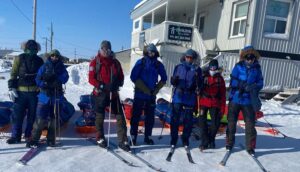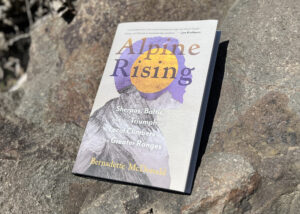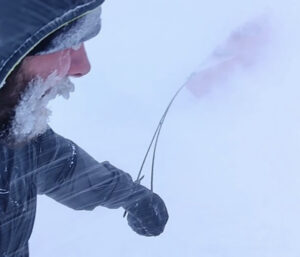It’s a well-used trope that freshly minted parents view the world in a new light after the birth of their children. I mostly avoided the cliché, with one exception. The burgeoning climate change anxiety I’ve been feeling for the last 10 years or so went into overdrive a few days after my son entered this world. It hasn’t slowed down since.
I thought about that anxiety quite a bit as I watched “Pleistocene Park”, a quirky new documentary by Luke Griswold-Tergis currently touring the mountain festival circuit. The film follows a beret-wearing, chain smoking Russian geophysicist named Sergey Zimov and his son Nikita as they attempt to stave off the melting of the Siberian permafrost.
If that sounds overwhelming, just wait. The Zimovs, along with their families and a cadre of stocky, muck-boot-wearing farmhands, are attempting to reach this lofty goal via the unusual — some would say impossible — method of returning the global north to the “mammoth steppe” ecosystem last witnessed over 10,000 years ago.
The theory
Current climate-change models don’t account for the massive amounts of carbon stored in permafrost, and that’s a real problem, as the icy layer is rapidly melting. The resulting feedback loop could speed up climate change in ways we can’t currently comprehend. Sergey Zimov’s theory and plan, assembled after decades of life and study in Siberia, is this:
- Snow is a good insulator, and when undisturbed, it keeps soil levels warm enough that the Earth’s recent uptick in temperature causes even more permafrost melting.
- Snow that is disturbed through the foraging action of millions of grassland fauna and megafauna leads to less insulated, cooler soil — cool enough to keep the permafrost frozen throughout the summer.
- The ecosystem needed to create this cooling no longer exists.
- The only way to create the needed ecosystem is to bring in grazing animals a few at a time, manage their populations until they number in the millions, and then steward them to terraform the environment.
- Maybe, eventually, cloned woolly mammoths join the party.
That’s exactly what Sergey and Nikita are attempting with Pleistocene Park. Little by little, they fundraise and scrape together cash and then purchase yak, moose, elk, horses, bison, and other animals, often transporting them vast distances across Europe and Asia to the park’s swampy 80-square-kilometre confines in Russia’s Sakha Republic.

Bemused European bison on a 30-day journey to Pleistocene Park. Photo: Screenshot
It’s a grueling, painstakingly slow process, and still more of an idea than a fully realized concept. And yet the two men soldier on.
The park is partly an experiment to prove Sergey’s theories. Partly it’s an investment in the future, as reaching the numbers of grazing animals needed to create the ecosystem in 50 years necessitates action now. Partly it’s an exercise in, as Griswold-Tergis says in the film, “pathological optimism.”
And partly it’s a grim battle against fatalism, the unforgiving Siberian elements, and plain bad luck.
Entropy
For a documentary chronicling an epic and lofty attempt at windmill tilting (or is it genius?), the film’s moment-by-moment rhythms are rooted in the miserable realities of trying to make any kind of ambitious project work at unforgiving latitudes. Clouds of mosquitoes abound. Mud is everywhere. Critical machinery is always breaking down, and the common method of repair seems to be a blend of Slavic curses and violent hammer blows.

A broken down truck in the middle of a month-long yak-transporting expedition. Par for the course at Pleistocene Park. Photo: Screenshot
There are always setbacks, and many are not overcome. Sergey smokes and stalks the larches or stretches out on a couch, his mood vacillating wildly between optimistic pride and bleak despair. Nikita stares blankly into the camera, his shoulders set with filial responsibility, his eyes reddened by weariness. He refuses to speculate on the park’s future success.
But he’s always in action — worrying over animals, trucking new additions across 11 times zones, felling trees, and running a Kickstarter campaign.
These scenes of changing tires and fretting over bison encapsulate the film’s themes. Where is the line between optimism and obsession? Is doing something — anything — about our oncoming climate disaster better than doing nothing at all?
We can see this battle between optimism and fatalism lurking behind every action in “Pleistocene Park” — a battle that connected deeply with me as a new father worried about the effects climate change will have on my growing family.
Pathological optimism
It took Luke Griswold-Tergis over eight years to make “Pleistocene Park”, and his film is a masterclass in what it means to gain the trust of a documentary subject. His camera captures the Zimovs with intimacy and familiarity, even as he himself is drawn into the park’s troubles and triumphs. The film’s editor Maureen Gosling also deserves major plaudits for taking what was surely hundreds of hours of achingly similar footage and weaving it into an effective narrative.
If the film has a flaw, it’s that it features not one but two extended sequences that involve transporting animals across great distances, and the two sequences are almost identical in challenges faced and overcome. But that’s life at Pleistocene Park — fighting the same battles over and over again, with little progress to show for it, but choosing to fight anyway.
The climate scientists interviewed in the film aren’t at all sure that Zimov’s plan will work. But to a person, they respect that someone is taking action. The days of half measures are over. Full commitment — even to an idea that seems, at best, implausible — is the only way forward.
Pathological optimism indeed.
Vice Media will broadcast/stream Pleistocene Park in early 2023.






